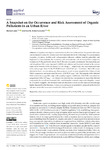Mostrar o rexistro simple do ítem
A Snapshot on the Occurrence and Risk Assessment of Organic Pollutants in an Urban River
| dc.contributor.author | Canle, Moisés | |
| dc.contributor.author | Antão-Geraldes, Ana Maria | |
| dc.date.accessioned | 2023-04-21T19:29:45Z | |
| dc.date.available | 2023-04-21T19:29:45Z | |
| dc.date.issued | 2022-12-22 | |
| dc.identifier.citation | Canle, M.; Antão-Geraldes, A.M. A Snapshot on the Occurrence and Risk Assessment of Organic Pollutants in an Urban River. Appl. Sci. 2023, 13, 146. https://doi.org/10.3390/app13010146 | es_ES |
| dc.identifier.issn | 2076-3417 | |
| dc.identifier.uri | http://hdl.handle.net/2183/32914 | |
| dc.description | This article belongs to the Special Issue Frontiers in Freshwater Ecology, Conservation and Water Treatment Technologies | es_ES |
| dc.description.abstract | [Abstract] A snapshot screening was carried out in an urban river at the end of a dry period in the water and sediments to assess the presence and environmental risk for the following CECs: paracetamol, ibuprofen, diclofenac, clofibric acid, carbamazepine, ofloxacin, caffeine, tonalide, galaxolide, and bisphenol-A. Concomitantly, the occurrence and environmental risk of sixteen PAHs congeners, six indicator PCBs, and twelve dioxin-like PCBs were evaluated in sediments. The most abundant and ubiquitous CECs were bisphenol A (BPA) and caffeine, and the total contents in the surface water varied between 90.95–212.18 and 3.17–167.38 ng·L−1, respectively. The concentrations found in lixiviates ranged from 134.94–772.85 (BPA) and 14.43–92.60 ng·L−1 (caffeine). Other CECs were detected in lower concentrations, and their presence varied between sampled sites. Values of total PAHs congeners in sediment varied between 10.39–52.91 ng·g−1 dw. The majority of the detected PAHs seem to have a pyrolitic origin with a small petrogenic contribution. Total PCBs’ concentrations ranged from 5.06 to 6.13 ng·g−1 dw. Despite the relatively low concentration of most of the detected compounds, the overall environmental risk, considering the screened compounds altogether, cannot be considered negligible. The obtained results are discussed in terms of other data available (though highly dispersed) in the literature. A four-color alert system is included to inform about the level of risk associated with the amount of each CEC, PAH, and PCB | es_ES |
| dc.description.sponsorship | IACOBUS program (Euroregion Galicia-North Portugal), through grants for inter-institutional research-purposed visits in 2018 (MC) and 2019 (AMAG). Foundation for Science and Technology (FCT, Portugal), FCT/MCTES to CIMO (UIDB/00690/2020 and e UIDP/00690) and SusTEC (LA/P/0007/2020). Xunta de Galicia (Spain), GPC ED431B 2020/52 | es_ES |
| dc.description.sponsorship | Portugal. Fundação para a Ciência e a Tecnologia; UIDB/00690/2020 | es_ES |
| dc.description.sponsorship | Portugal. Fundação para a Ciência e a Tecnologia; UIDP/00690 | es_ES |
| dc.description.sponsorship | Portugal. Fundação para a Ciência e a Tecnologia; LA/P/0007/2020 | es_ES |
| dc.description.sponsorship | Xunta de Galicia; ED431B 2020/52 | es_ES |
| dc.language.iso | eng | es_ES |
| dc.publisher | MDPI | es_ES |
| dc.relation.uri | https://doi.org/10.3390/app13010146 | es_ES |
| dc.rights | Atribución 4.0 Internacional | es_ES |
| dc.rights.uri | http://creativecommons.org/licenses/by/4.0/ | * |
| dc.subject | Urban river | es_ES |
| dc.subject | Water and surface sediments | es_ES |
| dc.subject | CECs | es_ES |
| dc.subject | PAHs | es_ES |
| dc.subject | PCBs | es_ES |
| dc.subject | Risk evaluation | es_ES |
| dc.title | A Snapshot on the Occurrence and Risk Assessment of Organic Pollutants in an Urban River | es_ES |
| dc.type | info:eu-repo/semantics/article | es_ES |
| dc.rights.access | info:eu-repo/semantics/openAccess | es_ES |
| UDC.journalTitle | Applied Sciences | es_ES |
| UDC.volume | 13 (2023) | es_ES |
| UDC.issue | 1 | es_ES |
| UDC.startPage | 146 | es_ES |
| dc.identifier.doi | 10.3390/app13010146 |
Ficheiros no ítem
Este ítem aparece na(s) seguinte(s) colección(s)
-
GI-REACT! - Artigos [103]






